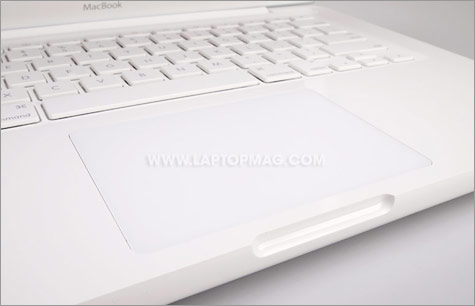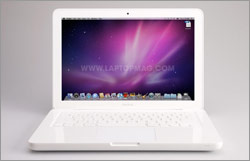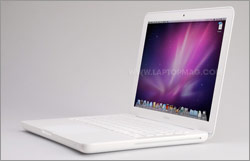Laptop Mag Verdict
The MacBook's refresh brings more powerful graphics and better battery life.
Pros
- +
Clean, elegant unibody design
- +
Excellent touchpad
- +
More than seven hours of battery life
- +
Fast boot time
Cons
- -
No SD Card reader
- -
Tinny speakers
- -
Bottom runs warm
Why you can trust Laptop Mag
Even though Apple only introduced the unibody MacBook last Fall, we weren't surprised that the company's consumer notebook saw a refresh shortly after the MacBook Pro line saw its upgrades. Like the Pros, the MacBook's updates are mostly limited to internal specs, with the same excellent outer design and $999 price remaining the same. Also true to the last generation, this new MacBook's specs are very similar to the 13-inch MacBook Pro, which costs $200 more. Apple draws the line between consumer and professional at aluminum vs. plastic, plus the number and type of ports on offer. Considering its excellent battery life, design, operating system and customer support, the MacBook remains a strong buy. But for the lower price you'll sacrifice some features.
Editor's Note:Portions of this review were taken from our review of the previous generation MacBook (2009).
Design
If you were to take a 13-inch MacBook Pro and replace the metal exterior with plastic, you'd pretty much have the MacBook. Its gleaming white glossy plastic interior and exterior--including the keyboard--continues the clean aesthetic of previous Macs, and hides fingerprints well, too. Like the MacBook Pros, this thin and light system also features a sturdy unibody construction. The result is a design that feels like it will stand the test of time.
While the aluminum-clad MacBook Pros with their black keyboards are definitely sleek, the all-white MacBook seems somewhat friendlier. The bottom panel, held in place by 8 screws, is coated in a soft light gray rubber, which keeps it from slipping around on a desk, and feels comfortable on your lap.
At 13.0 x 9.1 x 1.1 inches and weighing 4.8 pounds, the MacBook slightly larger and heavier than the 13-inch MacBook Pro (12.8 x 8.9 x 1.0 inches, 4.4 pounds), but isn't too great a difference that we couldn't carry it comfortably in our messenger bag.
Heat
After playing a Hulu video at full screen for 15 minutes, we measured the temperature of the MacBook in several places: the touchpad only got as hot as 81 degrees Fahrenheit, the space between the G and H key reached 92 degrees, and the underside of the notebook reached just 94 degrees. The hottest area of the notebook was nearest the hinge on the bottom, which measured a whopping 120 degrees. This was noticeable when on our lap and much hotter than the previous generation, which only reached 97 degrees during the same test.
Keyboard and Touchpad
Unlike the MacBook Pros, the MacBook's keyboard is not backlit; some concessions have to be made for the price. However, that seems to be the only concession. Not only is the island-style keyboard well-spaced, but the keys themselves were comfortable to the touch, and were snappy in response.
Apple has also brought the same touchpad as on its other notebooks: it doubles as the touchpad and the touch button. At 4.0 x 3.0 inches, not only is this trackpad the largest we've ever tested, but is very low friction, too. Like the 13-inch MacBook Pro, Apple's honed the design: we were able to effortlessly press down on the button without thinking about the fact that there's no dedicated touch button (nevermind two).
The multitouch gestures work smoothly, too. By pushing four fingers toward the top of the touchpad, we were able to fling windows up toward the top of the screen, exposing a clean desktop. When we used two fingers to zoom in and out of pages in Safari 4, the onscreen response was very quick. More importantly, it wasn't jerky and finicky, like the touchpad/button combo on the HP Envy 13. We were able to rest our left thumb on the pad and still move the cursor around without the notebook misinterpreting our movements.
Just as with the new MacBook Pros and the iPhone and iPad, Apple added inertial scrolling to the MacBook's touchpad. It makes getting around long webpages and Google Reader feed lists much easier, but users who find it annoying can disable it in the system settings.

Click to enlarge
Display and Audio
The 13.3-inch LED-backlit glossy display on the MacBook has a resolution of 1280 x 800, and images were bright and crisp. However, this system doesn't have the same 60 percent greater color gamut as the MacBook Pro line, so photo editors will want to think twice. Viewing angles were excellent from side to side, and unlike the previous generation MacBook, vertical viewing angles are just as good. We did note pixilation and blocky colors when watching both standard and high definition video streamed from Hulu and YouTube. Video played from the hard drive or DVD was smoother, but pixels were still noticeable.
While the speakers on the MacBook were loud, producing enough sound to fill a room, they were lacking in bass. Higher sounds, such as the drums and guitar riffs in Guns n Roses' "November Rain" tended to be somewhat harsh.
Ports and Webcam
The one area where we'd like to see Apple splurge a bit more is with its port and slot selection. The MacBook has two USB, a mini DisplayPort, Ethernet, and a headphone jack on the left side; on the right is the slot for the SuperDrive DVD burner. Considering their ubiquity (you can find them on $300 netbooks), we'd like to see an SD Card slot, as well as at least one more USB port. The Dell Studio XPS 13, for example, has all of the above, as well as FireWire and HDMI.
When conversing with a friend over Google Chat, she said that our image was clear, and the embedded mic picked up our sound well, but the camera on the MacBook had a hard time adjusting to lower-light conditions.

Click to enlarge

Click to enlarge
Performance

Click to enlargeThe MacBook's 2.4-GHz Intel Core 2 Duo P8600 processor is the same CPU available in the base 13-inch MacBook Pro and faster than the 2.26-GHz CPU in the last generation MacBook. It scored 4,259 marks in PCMark Vantage (running on Windows 7 via BootCamp), well above the 3,714 thin and light notebook average. It also comes out ahead of the previous MacBook (3,691) and the current generation 13-inch MacBook Pro (4,164), even though the latter system has 4GB of RAM to the MacBook's 2GB. It's only 40 points behind the Lenovo ThinkPad Edge 14, which has a 2.13-GHz Intel Core i3 M330 processor. However, the Lenovo IdeaPad Y460 (which has a Core i5-520M CPU) comes out way ahead with a score of 6,443, thanks to its ATI graphics.
Anecdotally, the MacBook sped along even after we opened multiple programs, including Scrivener, Safari, Firefox, and Garage Band, and streamed media from Last.fm and Hulu.
The 250GB, 5,400rpm hard drive was fairly speedy as well. In Snow Leopard it duplicated a 4.97GB folder of multimedia files in 2 minutes and 49 seconds for a file transfer rate of 30.1 MBps, well above average (22.4) and a sliver above the previous generation MacBook (27.8) and the 13-inch MacBook Pro (29.1). The IdeaPad Y460 (24.8), ThinkPad Edge 14 (21.7), and the ASUS U30Jc (20.9) all must bow to the MacBook's hard drive as well. In BootCamp the speed slowed to 19.6 MBps--still faster than the MacBook Pro (18.4 MBps). The drive booted into Snow Leopard in a speedy 38 seconds.
When transcoding a 114MB MPEG4 to AVI using Oxelon in BootCamp, the MacBook took 1 minute and 7 seconds; that's on a par with the category average (1:06), and 8 seconds faster than the 2010 13-inch MacBook Pro. Though equal to the ThinkPad Edge 14 (1:07) and faster than the U30Jc (1:12), the IdeaPad Y460 is faster yet again with a score of 54 seconds.
Graphics
The MacBook's integrated Nvidia GeForce 320M graphics processor with 256MB of shared memory notched an impressive 4,778 on 3DMark06, again slightly above the 13-inch MacBook Pro (4,754) and far above the previous generation MacBook (2,160) and the category average (1,829). The ASUS U30Jc (with an Nvidia GT310M GPU) comes closer with a score of 3,711, but the ThinkPad Edge 14's integrated graphics (1,486) isn't even in the MacBook's league in this contest. Predictably, the IdeaPad Y460, with a discrete ATI Radeon HD5650 GPU, is much more powerful (7,482).
While playing games in Windows 7 via BootCamp, we experienced good speed and smooth gameplay on both high-performance titles and less graphics-intensive games. In Far Cry 2 the MacBook averaged 47 frames per second with the resolution set to 1024 x 768, and the effects set to optimal; with the resolution at its max, and eye candy set to Very High, this number dropped to 19 fps. Both are well above the thin-and-light averages of 22 and 9 fps, respectively, and on a par with the 13-inch MacBook Pro and U30Jc. In World of Warcraft, the MacBook sailed through the game with framerates of 128 and 50 fps, respectively; that's almost exactly the 13-inch MacBook Pro's score (124/50). The more powerful IdeaPad Y460 scored 74/53 fps on the Far Cry 2 test and 214/59 fps in W.O.W.
Battery Life and Wi-Fi
On our LAPTOP Battery Test, the MacBook lasted 7 hours and 22 minutes in Snow Leopard. Though it lasted more than 2 hours longer than the previous generation, this runtime is nearly three hours short of the Apple's claim (10 hours), which, to be fair, is based on a less strenuous surfing test. The 13-inch MacBook Pro outlasted it, but only by 26 minutes. Still, this showing blows past the thin-and-light notebook average (4:52), and both the Lenovo ThinkPad Edge 14 (4:42) and IdeaPad Y460 (4:38 on integrated graphics). Of its Windows-based competitors, the ASUS U30Jc comes the closest, lasting 7:07.
While we could not perform our standard Wi-Fi test on the MacBook, we never wanted for connectivity. Even at 100 feet from our access point, all the bars of the Wi-Fi meter were still filled. The MacBook also comes with Bluetooth 2.1 + EDR.
Configurations

Click to enlargeUnlike the MacBook Pro line, which lets consumers choose different processors and screens, the only options Apple provides to potential MacBook customers is to upgrade the RAM to 4GB for an additional $100; a 320GB, 5,400rpm hard drive costs $50 more, and a 500GB, 5,400rpm drive adds $150.
Software and Warranty
Aside from its excellent Snow Leopard operating system, the MacBook comes loaded with Apple's iLife '09 creativity suite (iPhoto, iMovie, iWeb, and GarageBand), and its Time Machine backup software. While we're glad it doesn't have any trialware on it, we would have liked to seen a word processor a little less rudimentary than TextEdit.
Apple's standard warranty remains: one-year limited parts-and-labor and 90 days of toll-free, 24/7 phone support (Apple consistently aces our annual tech support showdown). The AppleCare Protection Plan, which includes three years each of parts-and-labor coverage and phone support, costs $249). To see how Apple fared on our Tech Support Showdown, click here.
Verdict
Thanks to its stellar industrial design, superior ergonomics, and above-average performance and battery life, the 13-inch MacBook ($999) is a compelling buy. Both price- and performance-wise, this notebook falls between Windows-based competitors like the ASUS U30Jc ($899) and Lenovo IdeaPad Y460 ($1,049), but beats both in terms of endurance. The main question is whether you'll want to spend an extra $200 on the 13-inch MacBook Pro, which has an SD Card slot, backlit keyboard, more RAM, and a sleeker aluminum chassis. If you can live without these amenities, the new MacBook is a very good value.
Apple MacBook (2010) Specs
| Bluetooth | Bluetooth 2.1+EDR |
| Brand | Apple |
| CPU | 2.4GHz Intel Core 2 Duo P8600 |
| Company Website | http://www.apple.com |
| Display Size | 13.3 |
| Graphics Card | NVIDIA GeForce 320M |
| Hard Drive Size | 250GB |
| Hard Drive Speed | 5,400rpm |
| Hard Drive Type | SATA Hard Drive |
| Native Resolution | 1280x800 |
| Operating System | OS X 10.6 (Snow Leopard) |
| Optical Drive | DVD+/-RW/+R DL |
| Optical Drive Speed | 8X |
| Ports (excluding USB) | Mini DisplayPort, Kensington Lock, Headphone, Ethernet |
| RAM | 2GB |
| RAM Upgradable to | 4GB |
| Size | 13.0 x 9.1 x 1.1 inches |
| USB Ports | 2 |
| Video Memory | 256MB |
| Warranty/Support | one-year limited parts-and-labor and 90 days of toll-free, 24/7 phone support |
| Weight | 4.8 pounds |
| Wi-Fi | 802.11a/b/g |
